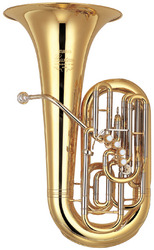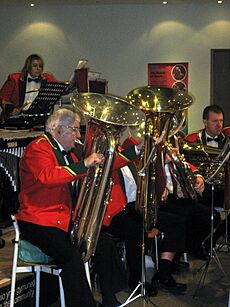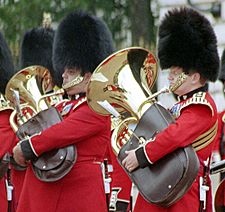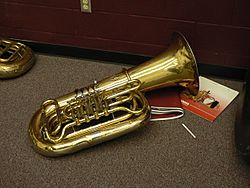Tuba facts for kids

A bass tuba in F with front-action piston valves
|
|
| Brass instrument | |
|---|---|
| Classification |
|
| Hornbostel–Sachs classification | 423.232 (Valved aerophone sounded by lip vibration) |
| Inventor(s) | Wilhelm Friedrich Wieprecht and Johann Gottfried Moritz |
| Developed | 1835 in Prussia |
| Playing range | |
| Related instruments | |
|
|
The tuba is the biggest and lowest-sounding musical instrument in the brass family. Like all brass instruments, you make sound by buzzing your lips into a mouthpiece. The tuba first showed up in the mid-1800s. This makes it one of the newer instruments in today's orchestras and concert bands. It mostly took the place of an older instrument called the ophicleide. The word tuba comes from Latin and means "trumpet".
A person who plays the tuba is called a tubaist, a tubist, or simply a tuba player. In a British brass band or military band, they are often known as bass players.
Contents
The Tuba's History
A special patent was given in Prussia on September 12, 1835. It was for a "bass tuba" in F. This patent went to Wilhelm Friedrich Wieprecht and Johann Gottfried Moritz. Their first tuba used five valves that were like today's piston valves. Moritz's son, Carl Wilhelm Moritz, invented the first tenor tuba in 1838.
How Valves Changed Music
Adding valves made it possible to play many more notes on brass instruments. Before valves, brass instruments could only play notes from their natural sound series. This meant they usually played very high notes. Valves allowed players to reach lower notes and have a full set of notes. This made the tuba much more versatile.
Older Instruments Like the Tuba
The ophicleide was an older instrument that used a brass mouthpiece. But it had keys and holes, like a modern saxophone. Another instrument before the tuba was the serpent. It was a bass instrument shaped in a wavy way. This shape helped the player reach its tone holes.
Tone holes change the pitch by letting air escape. But this also changed the sound quality a lot. By using valves instead, the tuba could make a smoother sound. This helped it become very popular. Famous composers like Hector Berlioz used the ophicleide in their music. Today, these pieces are usually played on the tuba.
Adolphe Sax also created a group of brass instruments called saxhorns. These instruments were often pitched in E♭ and B♭. The early tubas by Wieprecht and others were pitched in F and C. Sax's instruments became popular in France, Britain, and America.
The cimbasso is another instrument sometimes used instead of a tuba in orchestras. It's an Italian word that means "bass horn." Its design was inspired by the ophicleide and the bassoon. The cimbasso is sometimes used in older music performances. It is also often heard in film and video game soundtracks.
Where the Tuba is Used
An orchestra usually has one tuba, but sometimes two are needed. The tuba provides the low notes for the orchestral brass section. It also helps make the low sounds of the strings and woodwinds stronger.
The tuba is the main bass instrument in concert bands, brass bands, and military bands. These groups often have two to four tubas. The tuba can also be played as a solo instrument.
Tubas are also used in marching bands, drum and bugle corps, and many jazz bands. In British-style brass bands, two E♭ and two B♭ tubas are used. They are called basses in these bands.
Famous Tuba Music
Many famous composers have written important parts for the tuba. Here are some well-known examples:
- Modest Mussorgsky (arranged by Ravel): Pictures at an Exhibition – Bydło, Night on Bald Mountain
- Richard Strauss: Also sprach Zarathustra, Eine Alpensinfonie, Till Eulenspiegel
- Shostakovich: Most of his symphonies
- Stravinsky: The Rite of Spring, Petroushka
- Richard Wagner: Die Meistersinger von Nürnberg, Lohengrin, Ride of the Valkyries
- Sergei Prokofiev: Fifth Symphony, Romeo and Juliet
- George Gershwin: An American in Paris
- Gustav Holst: The Planets
- Gustav Mahler: Symphonies Nos. 1, 2, 3, 6, and 8
- Ottorino Respighi: Fountains of Rome, Pines of Rome
- Hector Berlioz: Symphonie fantastique, Hungarian March
Many composers have also written Concertos for the tuba. These include Ralph Vaughan Williams (Tuba Concerto), John Williams, Alexander Arutiunian, and Jennifer Higdon (Tuba Concerto).
Tuba Types and How They're Made
Tubas come in different musical keys, most often F, E♭, C, or B♭. The key depends on the tuba's lowest natural note. Tubas in different keys have different lengths of tubing. For example, a B♭ tuba's main tube is about 18 feet (5.5 m) long. A C tuba is about 16 feet (4.9 m), an E♭ tuba is 13 feet (4.0 m), and an F tuba is 12 feet (3.7 m). The tuba's tubing gets wider from the mouthpiece to the bell. This shape helps it produce a rich, full sound.
Different Shapes of Tubas
A tuba that sits on a player's lap is usually called a concert tuba. Some tubas have the bell pointing forward instead of up. These are often called recording tubas. They were popular when music was first recorded because their sound could be aimed at the microphone.
When a tuba is wrapped around the body for marching bands, it's called a helicon. The modern sousaphone looks like a helicon. It was named after the American bandmaster John Philip Sousa. Its bell usually points forward.
How Tuba Music is Written
Most music for the tuba is written in bass clef at its actual pitch. This means tuba players need to know the right fingerings for their specific instrument. However, in traditional British-style brass bands, tuba parts are often written in treble clef. This allows musicians to switch instruments without learning new fingerings. When written in treble clef, the tuba is a transposing instrument, meaning the notes sound different from what is written.
Tuba Sizes and Pitches
The lowest-pitched tubas are called contrabass tubas. They are pitched in C or B♭. These are often called CC and BB♭ tubas. A CC tuba's lowest note is about 32 Hz, and a BB♭ tuba's is about 29 Hz. The CC tuba is common in U.S. orchestras and bands. BB♭ tubas are popular in German, Austrian, and Russian orchestras. In U.S. schools, the BB♭ tuba is the most common.
The next size up are the bass tubas, pitched in F or E♭. These are a fourth higher than the contrabass tubas. The E♭ tuba often plays an octave higher than the contrabass tubas in brass bands. The F tuba is often used by professional players for solos. In Europe, the F tuba is the standard orchestral instrument.
The euphonium is sometimes called a tenor tuba. It is pitched in B♭, one octave higher than the BB♭ contrabass tuba. There are also very rare subcontrabass tubas that play even lower.
Tuba Size Designations
Tubas are sometimes described by a "quarter system," like 4⁄4 for a normal size. Larger ones might be 5⁄4 or 6⁄4. Smaller ones, often used by young players, might be 3⁄4. These terms help manufacturers describe their instruments. They are not strict standards. 3⁄4 tubas are common in American schools for younger students. They are smaller and lighter but play in the same key as full-size tubas.
Tuba Valves
Tubas use either piston or rotary valves. Rotary valves were first used in the 1840s or 1850s. Modern piston valves were developed around the same time. Piston valves can point up (top-action) or forward (front-action).
Piston valves need more oiling than rotary valves. Rotary valves are sealed and need less oiling. Piston valves are easier to take apart and put back together. Rotary valves are more complex and usually need a professional to fix.
Tubas usually have three to six valves. Three-valve tubas are often less expensive and used by beginners. The sousaphone usually has three valves. More advanced players often use four or five-valve tubas. Six-valve tubas are less common, except for F tubas.
How Valves Work
Valves add extra tubing to the tuba, which makes the pitch lower.
- The first valve lowers the pitch by a whole step (two half steps).
- The second valve lowers it by a half step.
- The third valve lowers it by three half steps.
When you use valves together, the pitch can sometimes be a little sharp. A fourth valve helps fix this. It can be used instead of certain valve combinations to make notes more in tune. It also helps the player reach the very lowest notes on the instrument. Fifth and sixth valves, if present, offer more ways to play notes in tune and make playing easier.
Compensating Valves
Some tubas have a special "compensating system." This system helps keep the tuba in tune when you use many valves together. This makes playing easier and means the player doesn't have to adjust tuning slides as much. This system was invented in Britain and is still very popular there.
The Blaikley design sends air through the first three valves a second time when the fourth valve is used. This helps correct the tuning. The downside is that it can make the instrument feel a bit "stuffy" or harder to blow through. It also makes the tuba heavier. But many players prefer this system for better tuning.
Tuba Sound and Materials
Some tubas can make very strong, low sounds that are not part of the usual musical scale. These are sometimes called "false tones." They allow the instrument to play even lower notes. A skilled player can make very deep sounds, sometimes even below what humans can easily hear.
Tubas are usually made of brass. The brass can be left natural, or it can be covered with lacquer or a thin layer of nickel, gold, or silver. Unfinished brass will get dark over time and needs to be polished to stay shiny.
Tuba Makers
Many companies make tubas around the world. In Europe, popular brands include Meinl-Weston and Miraphone, both from Germany. In Asia, Yamaha Corporation (Japan) and Jupiter Instruments (Taiwan) are well-known. From the United States, Holton Instrument Company and King Musical Instruments are famous brands.
Tuba Variations
Some tubas can be changed to a "marching" style. This means a special pipe can be added near the valves. The tuba then rests on the player's left shoulder, with the bell pointing forward. Some marching tubas are made only for marching and cannot be changed back to a concert model.
Most marching bands use the sousaphone. It's easier to carry because it was designed for marching. It's also usually cheaper than a true marching tuba. The older helicon is still used by bands in Europe. Drum and bugle corps players often use marching tubas or Contrabass bugles.
Regular tubas can also be played while standing and marching. This is common in British brass bands and military bands. To make it more comfortable, companies make special harnesses. These harnesses help hold the tuba so the musician can play it while standing, just like when sitting.
Tuba in Jazz Music

The tuba has been part of jazz music since it first began. In the early days, bands often used a tuba for outdoor shows and a double bass for indoor ones. The tuba was sometimes called "brass bass" to tell it apart from the "string bass" (double bass). Many musicians played both instruments.
This was especially true in the New Orleans jazz scene. The tuba was often used with Louis Armstrong's groups. It was a key instrument in his famous album Hot Five.
In modern jazz, tuba players sometimes play solos. New Orleans style brass bands, like the Dirty Dozen Brass Band, use a sousaphone for the bass sound. Tuba players like Bill Barber played on several Miles Davis albums. These included Birth of the Cool and Miles Ahead.
Images for kids
See also
 In Spanish: Tuba para niños
In Spanish: Tuba para niños
- Brass instrument valves
- Contrabass bugle
- Subcontrabass tuba
- Sousaphone
- Helicon (instrument)
- List of tuba players
- Roman tuba
- Tuba repertoire
- Tubachristmas (music event)
- Wagner tuba






